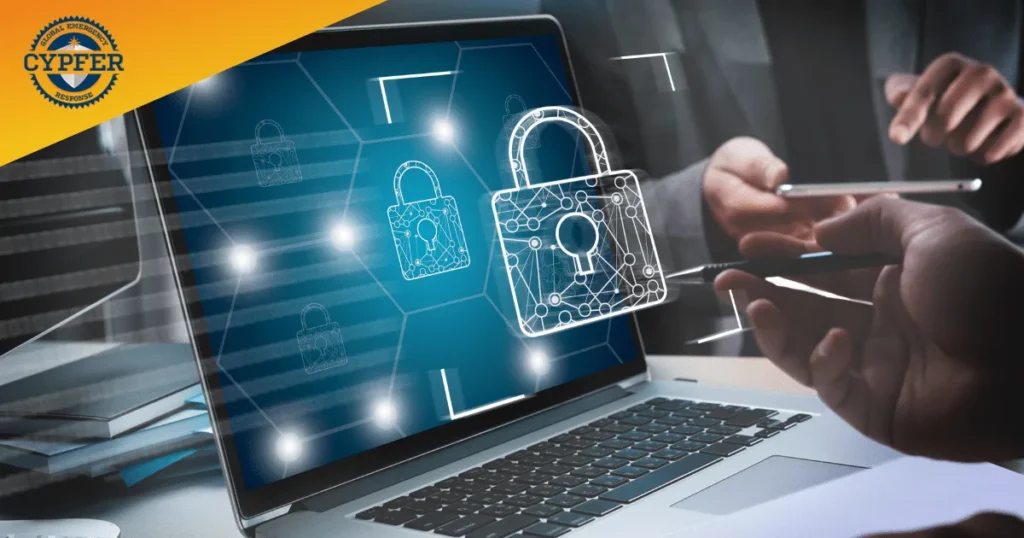
What is Cybersecurity ?
Cybersecurity is the practice of protecting systems, networks, and programs from digital attacks. These cyberattacks are usually aimed at accessing, changing, or destroying sensitive information; extorting money from users through ransomware; or interrupting normal business processes.
Types of cybersecurity
1. Network Security:
Network security is the practice of securing a computer network from unauthorized access or attacks. It includes the use of firewalls, intrusion detection and prevention systems, and virtual private networks (VPNs). The primary goal of network security is to protect a network’s infrastructure, including servers, routers, switches, and other network devices.
Key features of network security:
- Network monitoring and management tools
- Access control and authentication systems
- Data encryption and decryption methods
- Firewall technology
- Regular security audits
2. Application Security:
Application security refers to the measures taken to secure software applications from cyber-attacks. It includes testing the code, identifying vulnerabilities, and ensuring that the application is free from any security flaws. Application security can be implemented at various stages of the software development life cycle, from planning to deployment.
Key features of application security:
- Code review and vulnerability scanning
- Use of secure coding practices
- Implementation of secure authentication and authorization mechanisms
- Regular security testing and update
3. Information Security:
Information security involves the protection of digital information, such as data stored in databases, files, or other repositories. Information security ensures the confidentiality, integrity, and availability of data by protecting it from unauthorized access, disclosure, modification, or destruction. It includes various security measures such as access control, encryption, and backups.
Key features of information security:
- Use of access control mechanisms such as passwords, biometric verification, or two-factor authentication
- Encryption of sensitive data at rest and in transit
- Regular backups of critical data
- Implementation of disaster recovery and business continuity plans
- Monitoring and logging of system and network activity
4. Cloud Security:
Cloud security refers to the protection of data and systems hosted on cloud platforms, such as Amazon Web Services (AWS), Microsoft Azure, and Google Cloud. Cloud security includes a combination of technical and administrative controls that aim to secure data stored in the cloud, as well as the cloud infrastructure itself.
Key features of cloud security:
- Use of secure cloud configurations and virtual private networks
- Implementation of identity and access management controls
- Encryption of data at rest and in transit
- Regular security audits and compliance checks
5. Internet of Things (IoT) Security:
The Internet of Things (IoT) refers to the network of connected devices, such as smartphones, smart homes, and wearables. IoT security involves securing the devices themselves, as well as the network that connects them. As the number of IoT devices increases, so does the risk of cyber-attacks.
Key features of IoT security:
- Implementation of secure communication protocols
- Regular software updates and patches
- Use of strong authentication and access control mechanisms
- Data encryption and integrity checks
- Regular vulnerability assessments and penetration testing
6. Identity and Access Management (IAM):
Identity and Access Management (IAM) is the practice of managing user identities and controlling access to resources within an organization. IAM includes various security measures such as user authentication, authorization, and access control.
Key features of IAM:
- Use of strong authentication mechanisms such as biometric verification or two-factor authentication
- Implementation of role-based access control
- Regular security audits and compliance checks
- Implementation of password policies and regular password updates
Why cybersecurity is important ?
Protection of Confidential Information:
Confidential information such as financial data, personal information, and intellectual property are prone to cyber-attacks. Cybersecurity measures help to protect this information from unauthorized access, modification, or destruction.
Compliance with Regulations:
Various regulations and laws, such as HIPAA, GDPR, and PCI DSS, require organizations to secure their data and networks from cyber-attacks.
Protection of Reputation:
A cyber-attack can significantly damage an organization’s reputation, leading to a loss of business and trust from customers and stakeholders.
Prevention of Financial Losses:
A cyber-attack can cause significant financial losses, such as loss of revenue, lawsuits, and fines.
Business Interruption
Cybersecurity is vital to prevent and mitigate such interruptions, safeguarding a company’s stability and continuity in the face of digital threats.

Types of cybersecurity threats
Cybersecurity threats can come in various forms, and the following are the most common types of cybersecurity threats:
Malware: Malware is malicious software designed to harm or gain unauthorized access to a computer system. It includes viruses, worms, and Trojans.
Phishing: Phishing is a type of social engineering attack where cybercriminals trick people into giving away sensitive information such as usernames, passwords, and credit card details.
Ransomware: Ransomware is a type of malware that encrypts data on a victim’s computer and demands payment in exchange for the decryption key.
Denial of Service (DoS) Attacks: A DoS attack is an attempt to overwhelm a network or website with traffic, causing it to crash or become unavailable.
Insider Threats: Insider threats occur when an employee or contractor with authorized access to sensitive data or systems intentionally or unintentionally causes harm to an organization.
Advanced Persistent Threats (APTs): APTs are complex, targeted attacks designed to gain unauthorized access to a network or system and remain undetected for an extended period.
Now that we’ve discussed the most common types of cybersecurity threats let’s take a closer look at the six types of cybersecurity.
